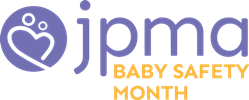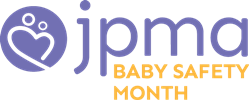
JPMA Baby Safety Month 2021
“Each year, Baby Safety Month is an important opportunity to spread awareness of critical, life-saving information to parents and caregivers of young children,” said Kelly Mariotti, executive director of JPMA.
MOUNT LAUREL, N.J. (PRWEB)
September 01, 2021
September is Baby Safety Month, an annual time to focus on safety considerations unique to babies and young children, established by the Juvenile Products Manufacturers Association (JPMA) nearly four decades ago to help parents safely navigate early childhood. With unintentional injury being the leading cause of death for children ages one to four, JPMA offers parents and caregivers critical safety tips and useful resources to help them choose and safely use age-appropriate products in the home and while on the go.
For the first time, Baby Safety Month will be a global effort. JPMA has partnered with The Infant and Nursery Products Alliance of Australia (INPAA), the Baby Products Association (BPA), the European Nursery Products Confederation (ENPC), and the Harrogate International Nursery Fair to raise awareness of Baby Safety Month internationally.
“Each year, Baby Safety Month is an important opportunity to spread awareness of critical, life-saving information to parents and caregivers of young children,” said Kelly Mariotti, executive director of JPMA. “With our first global Baby Safety Month, we’ve increased our reach to equip parents around the world with universal safety tips to follow while supervising young children during bath time, playtime, and on the go.”
Child Passenger Safety Week will be held during the third week of Baby Safety Month, Sept. 19-25, 2021. Virtual car seat education events will be provided by JPMA, top car seat brands, and several advocate groups. Parents and caregivers can find virtual seat check opportunities at http://www.jpma.org/page/cpsweek.
Babies are curious and want to touch, feel, lick, smell and listen to things within their environment. A priority for parents must be to ensure a child can safely explore every room in the home. To reduce injury risks, JPMA recommends parents and caregivers start each morning with a daily safety check for potential hazards in their home from baby’s point of view – down on hands and knees – and offers the following tips to help with common safety questions. For more information about Baby Safety Month and a complete list of safety tips, visit: http://www.babysafetymonth.org
Babyproofing, Home & Product Safety:
Unintentional injuries, such as burns, falls and poisoning, are leading causes of death for children in the United States, according to the Centers for Disease Control and Prevention (CDC). Most of these injuries are preventable by following these safety tips:
- Choose age and developmentally appropriate products and always read and follow all manufacturer’s instructions, recommendations for use and warning labels.
- Take care of obvious hazards like exposed electrical sockets and blind cords, but also look for not-so-obvious items like empty dishwashers, hanging tablecloths and poisonous plants.
- Consider babyproofing an ongoing process and always stay a step ahead. Monitor your child’s growth and development and discontinue using products as baby reaches the age or development limits defined by the manufacturer.
- Secondhand products should not be used for babies as they may not meet the latest safety standards. However, if it is necessary, make sure all parts are available, the product is fully functional, not broken, and has not been recalled.
- Register your products to establish a direct line of communication with the manufacturer should a problem arise. This information is NOT used for marketing purposes.
Bath Time Safety
In the United States, more children ages 1-4 die from drowning than any other cause of death except birth defects, according to the Centers for Disease Control and Prevention (CDC). Following a few guidelines can take the anxiety out of bath time and make the experience a safe and rewarding one.
- Collect all necessary bathing materials before bringing baby into the bathroom.
- NEVER leave baby unattended during bath time. If you need to leave the bathroom, take baby with you. Do not rely on older children to watch baby for you.
- Always check water temperature before placing a child in the bathtub or bath seat. To prevent scalding, water temperature at the faucet should be no more than 120 degrees Fahrenheit. Never add water to the tub while baby is in it.
- If using a baby bath seat, never lift the product with baby in it and position the bath seat in the tub so baby cannot reach the faucet or spout. If the bath seat moves or tips while baby is in it, discontinue use.
- Empty the tub completely immediately after each use to prevent any post-bath time drowning incidents.
Car Seats & Child Passenger Safety
Every 32 seconds, a child 14 and younger is involved in a crash while riding in a passenger vehicle. According to the National Highway Traffic Safety Administration, car crashes are a leading cause of death for children ages 1-13. Car seats can reduce the risk of fatal injury by as much as 71%, but mistakes in choosing, installing, or correctly using can compromise the protection they offer.
- Babies and young children should ride rear-facing until they reach the maximum rear-facing weight or height allowed by the manufacturer’s instructions.
- Children who exceed rear-facing limits should ride in forward-facing car seats with a harness until they reach the maximum weight or height allowed by the manufacturer’s instructions for harness use.
- Children who exceed the forward-facing harness limits should ride in belt-positioning booster seats until seat belts alone fit correctly.
- Follow your state law and the car seat instructions for proper selection and use, register your car seat with the manufacturer, and remember, the back seat is the safest place for children under 13.
- Do not use a car seat or booster car seat that is secondhand, especially if it is beyond its expiration date, has ever been involved in a crash or is missing the manufacturer’s label showing the name of the manufacturer, model number, and date of manufacture.
- Ensure everyone in the car is buckled up. Unrestrained passengers can be thrown with great force in a sudden stop or crash, possibly being injured or injuring others in the car.
- Never leave a young child alone in a car, not even for a moment, to prevent child vehicular heatstroke, often called “hot car” deaths.
Playtime & Entertainment Safety
With accidental injury being the leading cause of death for children between the ages for 1-4, taking the time to learn key entertainment safety practices can help save lives.
- Never leave baby unattended. It is important to stay in the same room as baby while using any bouncer, swing or activity center.
- Never place entertainment products on elevated surfaces, beds, sofas, or other soft surfaces. To avoid tip-over, only use infant swings, bouncers, and activity centers on flat, level surfaces.
- Always secure the restraining straps and never leave baby when straps are loose or undone.
- Never place an infant swing, activity center or bouncer near windows, stairs, draperies, blinds, TVs, plants, fireplaces or decorative accessories with long cords that baby could reach.
- Be sure to follow the manufacturer’s recommended age, weight, and height for infant swings, bouncers, and activity centers and discontinue use when baby outgrows them.
JPMA would like to thank the following partners for supporting this year’s Baby Safety Month:
American Home Furnishing Alliance, Baby Carrier Industry Alliance, Baby Products Association, Charlie’s House, Childproofing Experts.com, European Nursery Products Confederation, First Candle, Gugu Guru, Harrogate International Nursery Fair, The Infant and Nursery Products Alliance of Australia, Injury Free Coalition For Kids, International Association For Child Safety, Kids and Car Safety, Mommy MD Guides, National Diaper Bank Network, Pregnant Chicken, Retail Industry Leaders Association, Safe Kids Worldwide, Advocates for Highway and Auto Safety, The Genius of Play, The Toy Association, Twiniversity, Walmart, Window Covering Safety Council, Women Certified, Zero To Three, and Association Headquarters.
———
About Baby Safety Month
Baby Safety Month started in 1983 when JPMA initiated “Expectant Mother’s Day.” In 1986, it was extended to a week-long celebration, until 1991, when JPMA sponsored the first “Baby Safety Awareness Month.” Since then, every September has been designated as Baby Safety Month.
About the Juvenile Products Manufacturers Association (JPMA)
The Juvenile Products Manufacturers Association (JPMA) is the voice of the industry on quality and safety for baby and children’s products in North America. We work to advance the interests of manufacturers, parents, children and the industry at large by advocating for safety through product certification programs and legislative and regulatory involvement. We support our broad and diverse membership through member-only programming and industry promotion, and we act as a comprehensive source for baby product information and education.
JPMA members represent 95 percent of the prenatal to preschool products sold in North America. To find out more about JPMA, our Certification Program and Certified products, and for a complete listing of JPMA Members, please visit https://www.jpma.org. Follow JPMA on Twitter @JPMA, on Instagram @JPMABuiltforBaby and connect with us on Facebook to learn about additional safety tips and JPMA initiatives.

